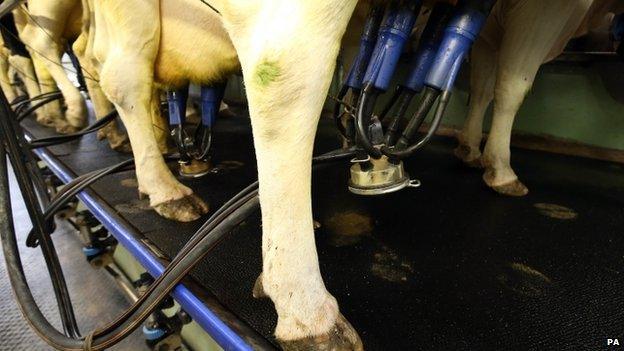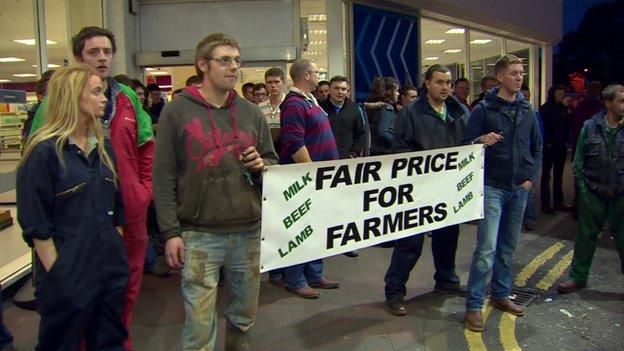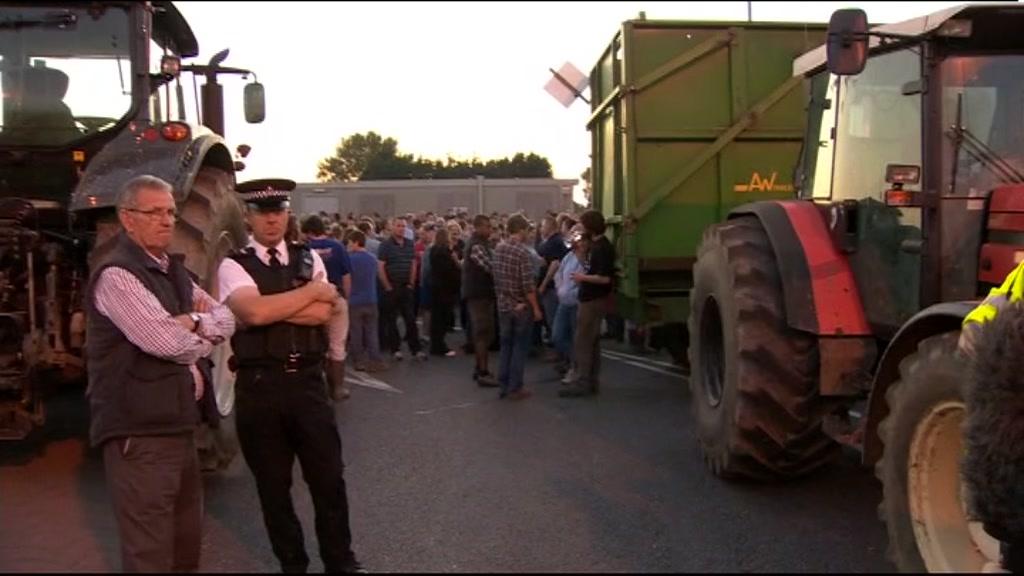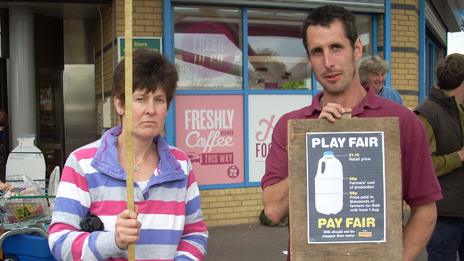Q&A: Milk prices row and how the system works
- Published
UK dairy farmers are being forced out of business because of the low price of milk, industry leaders warn. In protest at their plight, farmers have been blockading milk distribution centres and even bringing cattle into supermarkets.
What is the row over milk and who does it involve?


Why are farmers protesting?
Dairy farmers say they are in "crisis" because of the continuing fall in the price of milk.
Put simply, it is costing farmers more money to produce milk than the amount they receive when they sell it.
Figures released by the Department of Food and Rural Affairs (Defra) for June 2015 put the average farm-gate price - which is the amount of cash farmers receive - at 23.66 pence per litre (ppl), the lowest for five years and down 25% in the last 12 months.
However, farmers estimate that it costs between 30 and 32p to produce a litre of milk.

How are supermarkets involved?

The National Farmers' Union (NFU) argues that a supermarket price war, which has seen a 2.3-litre bottle of milk sell for 88p, has devalued the product in the eyes of the public, "purely to get customers through the door".
Farmers do not sell milk directly to shops. It is collected from farms by a milk processor who then bottles it or turns it into other dairy products such as cheese, butter or yoghurt.
Supermarkets buy milk from the milk processor. Due to commercial confidentiality, it is not known how much supermarkets pay for milk or how much profit, if any, supermarkets make on their milk sales.
However, some retailers - including Waitrose, Marks & Spencer, Tesco, Sainsbury's and the Co-op - have schemes in place to ensure farmers are paid a price above the average cost of production for fresh milk.
Morrisons, Asda, Lidl and Aldi do not offer these deals, but the NFU says talks are ongoing with Morrisons to reach one.
Meanwhile, the supermarkets say there is no link between the price of milk on the shelves and what farmers are paid.

What other factors are affecting the price fall?

Dairy farmers are competing in a global market place and supply is exceeding demand.
Milk production in the 28 EU member states remains above 2014 levels.
Farm-gate prices are at an average of 34.08 euro/100kg, equivalent to 22.69ppl - which is their lowest point since June 2010 and further price cuts are expected.
At the end of March the European Union lifted its quotas on the amount of milk farmers could produce.
The NFU and the industry body AHDB Dairy also acknowledge that a Russian ban on imports and a collapse in demand from China for diary products have played a part in the problem.

What is the impact on the dairy industry?
The number of dairy farmers in the UK was estimated to be at 25,000 in 2000.
In December 2014, the number had dipped below 10,000 for the first time - a 50% fall since 2001 - according to the NFU.
AHDB Dairy figures for July 2015 show there are now 9,724 farmers in England and Wales.

What is the Milk Trolley Challenge?
It's a term which has been attached to protests around the country, aimed at raising awareness of the issue.
The Milk Trolley Challenge originated in Yate, south Gloucestershire, when a group of farmers were filmed lining up trolleys in a Morrisons supermarket before emptying the shelves of milk.


What do consumers think?
A survey of 1,270 milk drinkers by market research organisation Mintel in June found 51% would be prepared to pay more than £1 for four pints of milk. The average price people were willing to pay was £1.28. Currently, normal supermarket prices range from 89p to £1.

- Published10 August 2012

- Published23 July 2012

- Published21 July 2012

- Published20 July 2012
